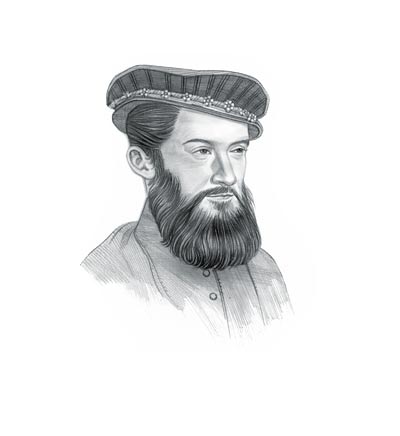An Obscure French Connection
Ribault - http://www.facts-about.org.uk
You may have noticed recent posts here and there with the hashtag "lyonenretro" on my Instagram feed. I spent an amazing month in Lyon, France over the summer. The experience was everything I hoped it would be. New friends and deep connections were made that I hope will send me back there soon. Ahead of my travels, I did some preliminary research on possible links between France and St. Augustine. I found some intriguing material, but didn't get my hands dirty until a six day Hurricane Irma evacuation. After returning to St. Augustine, I had an intriguing conversation with Government House personnel about a September 1565 hurricane that was a major player in the account that connects France to northeast Florida. The parallel event gave me chills. Here we were in the recently ravaged historic district, discussing a hurricane that occurred practically on the same dates 452 years prior. My curiosity also led me to Aviles Street's Historical Society Library and Flagler College for some nostalgic study sessions.
I learned that France played a significant, though lesser known role in St. Augustine's history. The account is sometimes described as 'incomplete and imperfect.' After revisiting this subject repeatedly for at least eight months, I tend to agree.
In 1562, French explorer Jean Ribault came to northeast Florida to establish a new colony. He traveled with three ships along with 150 Protestants (known in French as Huguenots). They landed near St. Augustine and hoped to drive out Spanish settlers to take control of the newly discovered land. As they sailed further north, the St. Johns River was discovered (on April 30, 1562) and temporarily renamed the "River of May." It was at the mouth of this river that Ribault built a monument to mark his presence and claim the territory for his native France.
Before long, supplies ran low and Ribault returned to France to replenish. Religious conflict prevented him from raising money and purchasing needed materials. Ribault then approached Queen Elizabeth of England for assistance. She initially listened with great interest to his accounts of Northeast Florida. Perhaps to Ribault’s surprise, the Queen later had him imprisoned in the Tower of London for establishing a French Colony in Spanish Territory. At least one English Catholic (Thomas Stucley) sought to discredit Ribault by way of a scheme to have him suspected of treachery.
Laudoninière - http://www.wikiwand.com/fr/
After escaping from prison in 1565, Ribault was again sent to the States. This time, he was commissioned at the hand of Admiral Coligny with 500 soldiers circa May 22, 1565. This expedition overlapped with that of Pedro Menendez's Florida arrival. It could be that Ribault caught wind of Menendez's expedition. In an effort to drive the French out of Florida, Menendez erected a fort south of Fort Caroline (built by Ribault's lieutenant Rene Laudonnière during his prison term) and trained his men for what would turn out to be a bloody battle.
On September 4, 1565, Menéndez realized that Ribault beat him to the River of May and planned a nighttime sail and an attack the following morning before the French could prepare.
By most accounts, Menendez adamantly ordered that women and children found at Fort Caroline be spared. “There were some 50 persons who were either women, infants, and boys of 15 years or under...I have feared that our Lord would chastise me if I should deal cruelly with them,” wrote Menendez. Meanwhile, Nicolas Le Challeux (a survivor of the massacre) had another recollection of the matter: “The Spaniard...arrived the [twentieth day of September] in the morning, with the weather very rainy, and, entering with no resistance in to the fort, committed a horrible execution of the rage and fury that they had conceived against our nation, each trying to outdo the other in slaying men, healthy and sick, women and babies, of the sort that it is not possible to dream of a massacre that is equal to this one in cruelty and barbarity.”
Le Challeux's account highlights the horror and bewilderment of waking up to find Spaniards and Native allies inside the fort. The instinctual impulse of the French was to flee rather than fight. The one sided massacre moved Le Challeux to reflect that “...I would not find greater cruelty among wild beasts.”
Le Challeux was the sole eyewitness to state that the Spanish executed women and children. Neither Laudonniere nor Jacques Le Moyne (a survivor of the massacre) made this claim. Le Moyne's account does make a minor reference to Laudonniere's maidservant: “She was wounded during the attack and fled to safety with Le Moyne.”
In retrospect, Menendez's knowledge of the exact composition of Ribault's forces served him well. His determination was also likely fueled by frustration over the threat posed by the French to his colonization and financial enrichment efforts. Menendez's view of Ribault as a threat can be seen from a letter he wrote to King Philip II on August 13, 1565:
“It is chiefly important that I should arrive in Florida before the French, and in all reason, judging from the speed with which I have come thus far, and shall go from here to Florida, I shall arrive before them, and although in doing this, we incur some risk, and undertake great labors, yet it seems to me that we ought not to, for these reasons to fail to venture; for if the French should arrive first in Florida, all the force that I have, although it go all together, is to small to attack them.”
For reasons one can only speculate, Ribault did not seem to have the same sense of urgency. His fleet crossed the Atlantic further north than their Spanish counterparts. This meant they steered clear of the “adverse weather that bedeviled” Menendez. Ribault reached Florida's coast by August 14, landing upward of 100 miles south of Fort Caroline. Ribault and his men stopped to question a shipwrecked Spaniard before continuing north. They reached the River of May (St. Johns River) about two weeks later on August 27/28. Meanwhile, Rather than go by way of the Bahama Channel (less direct and posed the risk of an encounter with Ribault's fleet), Menendez traveled through the center of the uncharted Bahamas archipelago. This route meant dangerous reefs, but it might have saved Menendez a few days of crucial time.
In his third book, Laudonniere wrote: “I will plainly say one thing, that the long delay of Captaine John Ribault used in his embarking, and the 15 days that he spent roving along the coast of Florida, before he came to our Fort Caroline, were the cause of the loss we sustained.”
Ribault embarked on a nautical quest to seize St. Augustine, but was shipwrecked in a major hurricane on September 10/11, 1565. It took his vessels so far south that they eventually made landfall somewhere between Daytona Beach and Cape Canaveral (nps.gov). Upon his arrival in St. Augustine, the Spanish were significantly outnumbered. They had meager food supplies and inadequate defenses. Chaplain Mendoza Grajales recounted: “If the French had attacked at once when they arrived, it would have been a very great capture, because our people were not supplied with arms and were carrying provisions.” Nonetheless, when Ribault arrived, he allowed time for his ships to traverse the shallow harbor entrance and anchored outside the harbor while demanding Menendez's surrender. There is disagreement among Spanish sources regarding how long the French waited outside of St. Augustine's harbor.
To be sure, there exists disagreement about more than one aspect of this account. With that in mind, my intention is to revisit this subject periodically and update this post as needed. This story was fodder for a related question: how did European explorers communicate with Native Floridians? Language development fascinates me. I hope to find reliable data on this subject for an upcoming project. Thanks for tagging along for this historic ride!
Text Sources...
Lyon, Eugene. The Enterprise of Florida: Pedro Menéndez de Avilés and the Spanish Conquest of 1565 -1568. Univ. Press of Florida, 1999.
McGrath, John T. The French in early Florida: In the Eye of the Hurricane. University Press of Florida, 2001.




![‘Realistic #optimists...strongly believe that they make things happen and that they will succeed. They have no doubt about it. [...] On the other hand, they perfectly know that in order to be successful they have to plan well, access all necess](https://images.squarespace-cdn.com/content/v1/576f2bee29687f12f6888b55/1592923330718-NNA4QHRAD6Y7Y9RZSV2Z/image-asset.jpeg)







